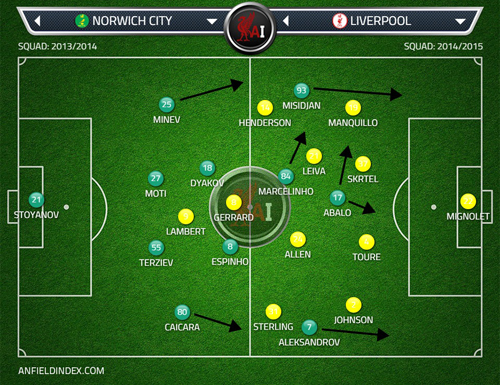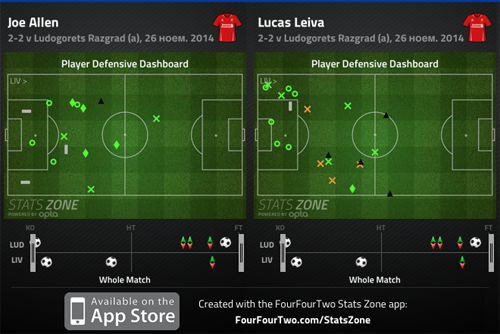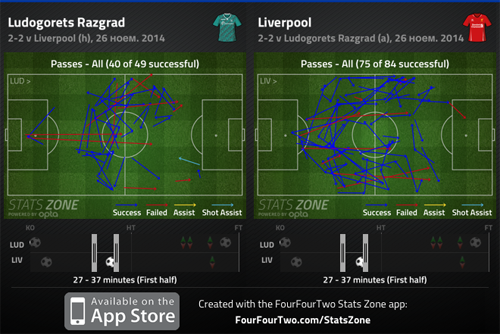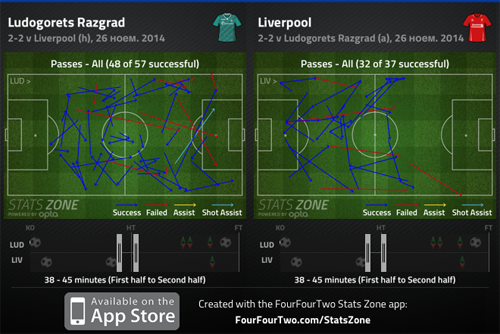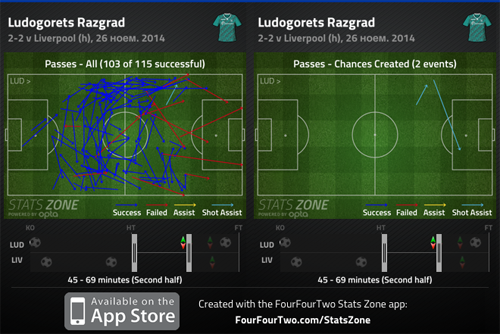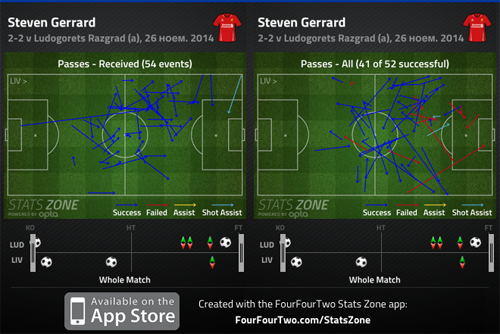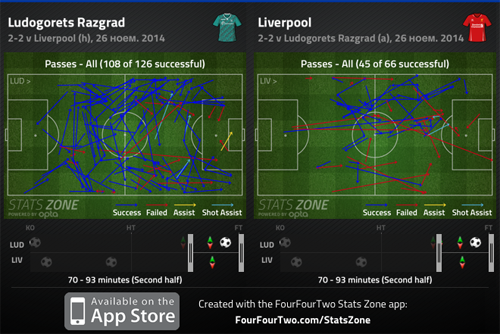By Mihail Vladimirov.
Summary:
- Ludogorets opted for their usual 4-2-3-1 formation, Liverpool started with a surprisingly defensive 4-4-1-1, with Gerrard moved forward to support Lambert.
- Because of the shape and personnel, the potential for tactical changes were rigid and limited.
- Marcelino was the playmaker in the home team’s side, looking to pick out the three attacking wingers ahead of him.
- Allen and Lucas were effective when Liverpool had the ball, but caused problems for the defence by not splitting their roles (off-the-ball) effectively. They both tried to press and attack the man in possession, rather than take it in turns or simply allow Lucas to sit deep, and Allen to press the player with the ball.
- The Reds started well, in terms of solid, patient periods of possession.
- Both opening goals were mainly down to individual lapses, although Ludogorets’ opener might have been prevented had Lucas not committed and left the space in front of the back four.
- The home team created plenty of chances throughout the match, but their individual quality let them down.
- In the second half, especially in the last 20 minutes of the game, Ludogorets attacked with their whole team (apart from the centre-backs), and although they were restricted in open play, Rodgers’ lack of in-game management meant the Reds had no outlet to attack. So remained under pressure throughout.
In terms of starting XIs, both managers surprised with their choices. For Ludogorets, Dermendjiev unexpectedly opted to put the winger Dani Abalo as his most advanced forward in what was the usual 4-2-3-1 formation. Apart from that surprise, everyone else was as expected and in their usual positions.
On the other side Rodgers surprised by starting with what was essentially a cautious 4-4-1-1 formation, with Lucas and Allen played together for the first time this season as the midfield pair. Gerrard moved forward in support of Lambert with Sterling and Henderson playing on the flanks.
The possible scenarios based on the starting XIs
What was interesting to note, based on the starting XIs, was how both managers’ selections were quite rigid. Although choosing some of the personnel was in itself a surprise, the possible variants of how both teams might have lined-up were few and far between. This made both teams rather predictable and the intentions of both managers were obvious even before the game started.
For Ludogorets the main dilemma was whether Marcelinho would play in his usual position as the advanced midfielder or will be used as the false 9 upfront. The presence of the three wingers in the line-up allowed for both variants and while the movement permutations would have been different, essentially Ludogorets would have looked direct and counter-attacking oriented in either scenario.
In case Marcelinho started up front, it would have been expected to see him continually drop deep to link-up the play on the break and play balls on the getting beyond him three direct players (Misidjan, Abalo and Aleksandrov). The same thing would have happened in the alternative variant with the difference being that Marcelinho would start deeper and be easier for him to pick up the ball and initiate dangerous attacking moves by quickly feeding the runs of the three players sitting ahead of him.
For Liverpool, the case was similarly predictable. With the selected XI, there were two possible variants of how Rodgers could have approached the game. The first one was to go with a 4-diamond-2 with Lucas at its base, Gerrard at the tip and Allen and Henderson as the shuttlers. The other was to see a very reactive 4-4-1-1 formation with Sterling and Henderson on the flanks, Gerrard pushed forward just-off Lambert with Lucas and Allen playing in midfield to hold the fort.
Although the diamond formation was a viable option, arguably it was unlikely Rodgers used it. This is mainly because of its inherent defensive weaknesses, which have been repeatedly exploited this season by various teams (one of which was Ludogorets in the return game at Anfield). In a game where Liverpool must avoid defeat at all costs this would have been too much of a risk, so logically Rodgers didn’t go for it. This meant the other only viable alternative was preferred instead.
Based on the selected personnel and chosen formation it was clear Liverpool aimed to be as defensively solid as possible, shutting up the space through the middle, defending the wide areas (where Ludogorets’s main strengths lie) by doubling up the full-backs with two mobile, energetic and hard-working wide men (Sterling and Henderson) and trying to use the ball in a sensible way to further calm the tempo and ensure they are not pinned back. The presence of Gerrard and Lambert in attack meant the Reds would offer little immediate counter-attacking threat, as neither of the front pair was mobile enough to offer the required movement or pace. This meant that either the team will look to break forward down the flanks – counting on the pace and dynamism of Sterling and Henderson in attack too – or they will look to gradually push forward, passing the ball methodically and looking to sustain their possession higher up as a means of penetration.
With both teams’ main aspects of their approaches predictable before the game, the actual contest wasn’t much of a surprise. The only question was who between the two of them will prove to be more dominant or efficient in attack – Ludogorets’ direct attacks or Liverpool’s calm possession – as out of possession both teams would defend in largely the same two banks of four with the front pairs dropping deep to make the side more compact.
First half – both teams having spells of domination
The main feature of the first half was the fact that both teams had periods of domination and being dominated with these periods switching over a couple of times. This shouldn’t be a surprise as rarely does a game happen with one team being in control and the other under the cosh all the time. But based on the starting XIs and the expected approaches it was expected the game – at least for the majority of the first half – to follow the script of Liverpool dominating possession in deep areas and trying to morph it higher up while Ludogorets waited for suitable chances to break forward.
Obviously, there could have been certain nuances of such a game context. For example, Ludogorets might have been tasked to press hard and look to regain the ball quicker and from higher up to then allow them break forward using the pace and directness of their attackers. Alternatively, Liverpool could have used their shape and personnel to simply sit back and not really looking to dominate with the ball. Still, as a whole, the importance of the game and the fear of elimination arguably made the teams much more cautious and reactive.
Expectedly, the game started with Liverpool settling into possession dominance and as a result having control over the game right from the off. The team passed the ball well in their own half, providing the required sustained ball retention process to allow the full-backs and the wide men to have the time to push on and get up in support to the immobile front duo.
Lucas and Allen’s presence deep in midfield allowed the visitors to set up such possession dominance. The two of them split their positions effectively when it came to one of them dropping deep to pick up the ball from the centre-backs, leaving the other to roam around to provide the next passing option. Their solid and composed presence on the ball created that solid possession platform to put Liverpool in the driving seat from the start, while allowing the team to gradually push up and spread out properly in attack. In the opening 10 minutes, the Reds had a few nicely constructed passages of possession, which evolved into good attacking moves inside Ludogorets’ half.
Interestingly, in that opening spell of ten minutes when everything seemed calm and under Liverpool’s control, both teams scored a goal. However, it could be said that both goals came largely out of the blue with the attacking team not really doing anything special to deserve such an outcome; it was mainly down to the shambolic defending of the opposition. Ludogorets opened the scoring in the third minute when a shot from outside the box was poorly handled by Mignolet who spilled the ball and the onrushing Abalo managed to tuck it into the back of the net. Five minutes later a punt of a forward pass by Lucas into the box was equally poorly cleared by Moti, then his misunderstanding with the ‘keeper resulted in Lambert gifted an easy chance to head the ball home.
However, for all the good things Liverpool showed in possession, right from the start there was a clear problem in their defensive set up. As much as Lucas and Allen’s presence proved to be the main pillar in Liverpool’s possession play, they also seemed to be the main defensive issue.
Simply said, they struggled to divide their roles out of possession as well as they did when on the ball. Too often, throughout the whole game, they duplicated their activities and either both stayed too deep or both looked to step up and engage the opposition (this happened more often). Such a duplicating of their defensive roles always left Liverpool wanting through the middle – it was mainly a case of the space ahead of the centre-backs often being left unprotected, as both Lucas and Allen seemed to go and close down the opposition.
As Ludogorets’ first goal nicely illustrated, the problem with this was that one of them is bypassed, the other is not sitting in behind to cover the space and there is immediately a hole left to be exploited. Sure, for the goal situation Toure’s interception could have been much better and, especially, Mignolet’s reaction to the shot could have been more assertive, but the point is the situation might not have led to that outcome if Lucas wasn’t so easily bypassed in the build-up and Allen had the nous to stay back and cover instead of also pushing forward to press the ball.
On paper it was rather surprising to see the team’s midfield pair looking so proactive with their defensive behaviour, given how it seemed the whole emphasis was being cautious, reactive and solid in that 4-4-1-1 formation. Was it because Lucas and Allen felt obligatory to press more and not leave too much time on the ball for Ludogorets’ driving forward players, as it was clear Gerrard and Lambert did not do that? Alternatively, was it just a sign of poor organisation and not specific/clear enough instruction from the manager about how the midfield pair is supposed to split when out of possession as well as when on the ball?
It was interesting to see that Lucas was placed as the right-sided central midfielder – precisely down the channel Ludogorets seemed to focus their play. Similarly, to Crystal Palace, Ludogorets seemed to target Liverpool’s right flank. But instead of this being as a result of trying to exploit a particular weakness in the Reds’ defence, it was arguably just an effect of having Misidjan over there (who similarly to Bolasie is a strong and powerful runner on and off the ball) with Abalo and Marcelinho more often than not both also drifting down their left. This was perhaps the main reason as to why Lucas felt the need more often than not to go on the front foot and engage the opposition as he was seeing how Ludogorets put emphasis on their left.
The problem though was that left Allen as the covering player, which is not really what he is good at, while Lucas was forced to be the enforcer – which is again something he, with his lack of mobility and pure strength, is not really as adept to do. Allen is better at quickly putting pressure on the opposition as he could use his agility either quickly intercept the ball or swiftly nick it off the opposition. It would have been more useful – based on what was happening on the pitch – to see Lucas and Allen swapped, as this would have suited their skills and style better. Allen to press, joined by Henderson who was also trying to both cover for Minev’s overlaps and do his best to close down around that zone, using his mobility and aggressiveness; Lucas to remain rather static ahead of the centre-backs in a covering position, using his good reading of the game to position himself and cut-off any danger.
Another interesting aspect of the first half was how visibly Liverpool simply dropped off as soon as they equalised. Instead of seeing them ride on the wave of increased confidence given how quick they pegged back Ludogorets after the opening goal, it was a case of the Reds somewhat stopping play. Perhaps they just felt the need to ensure they won’t be as easily cut through as in the third minute, so they dropped-off and looked more focussed to remain solid and see what happens next in the game.
This gave opportunity for the home team to gradually start to push forward and come at Liverpool more and more with each passing minute. In the next 15 minutes or so Ludogorets were clearly the more dominating team, roaring forward as soon as they had the ball, stretching the play and driving powerfully at Liverpool. The more possession the hosts had, the more opportunities they had to look dangerous going forward. In that spell of domination, Dermendjiev’s players created a succession of threatening moments and were very close to score another goal.
First, in the 15thminute, Ludogorets broke down the left hand side and after very nice build-up play found the unmarked Minev into the box, whose curling shot was off target. Four minutes later another attack down that side saw Abalo get in behind the defence to then backheel to Misidjan who tried to immediately square the pass to the onrushing Marcelinho into the box to send him in a clear goal-scoring position – but Toure made the crucial interception to clear the danger. In the 20th minute, more good wing play – this time down the opposite flank – saw Aleksandrov played into a good position in behind to cross the ball – in contrast to before, Toure was this time an inch away to score an own goal with his clumsy clearance. Apart from the succession of dangerous moves from open play, Ludogorets also had a few dangerous set-plays in that period of dominance. Their best chance from that route came in the 25th minute, where Marcelinho couldn’t really connect properly with the ball incoming from the right following a cross from an indirect free-kick. Had he done so to hit the target, it would have been a sure goal given it was a free header and Mignolet failed to get to the ball.
The contrast in both teams’ approach was clear by how different they looked in their spells of domination. Liverpool were very possession-based, which was their only option to use the selected personnel in a suitable way. They couldn’t really knock direct balls forward and hope Gerrard and Lambert will break in behind. Therefore, their only option was to get on with their work in a more methodical and slower manner – which, as noted above, they did quite well.
In contrast, in their spell of domination, Ludogorets looked a lot more direct than Liverpool, keen to quickly put the ball forward and let their front quartet – often joined by the overlapping full-backs – create something in attack using their individual abilities to run forward with the ball and combine in a swift manner, exchanging some neat passes in the build-up. Given their starting XI it was the only viable way to suit the type of players they had in attack with the wingers staying wide, picking up the ball and then running forward while Abalo was constantly on the move to work the channels and further stretch the play, leaving Marcelinho to pick them out from his deeper position.
But then, as soon they sparkled into life, Ludogorets dropped their attacking intensity and it was Liverpool’s turn to again settle into a more controlling position into the game.
The fact neither team succeeded – or wanted – to extend their dominance more than the brief 10-15 period could be easily explained. First, both teams already paid the price for cheap errors leading to conceding what were preventable goals. In addition, the dominating position switching over every ten minutes or so, throughout the whole first half, was a sign of neither team having the confidence and/or the ability to stamp their authority over the game and make the tempo suit them. For Ludogorets this was because of their poor overall quality and, more or less, being respected by the big name of Liverpool. For Liverpool, it was more to do with their current horrible form, lack of confidence and arguably fear of losing yet again in such an important game, which transpired into their extra cautious mentality for this game.
Apart from anything else, the fact Liverpool rarely played from the back in this game was a clear sign of their lack of confidence and the extra level of caution Rodgers wanted from this game. From open play, the ball was as per usual sometimes passed back to Mignolet. Nevertheless, when it comes to Mignolet’s use of the ball, he was – presumably under explicit instructions – usually direct and keener to play it long, rather than insist on keeping it short. All of his goal-kicks (except one) were played long with his preferred passing option being Lambert, rather to one of his nearest players (towards Lambert – 13, towards Toure and Skrtel combined – 8).
In their second spell of domination – between the 27th and 37th minute – Liverpool didn’t do anything different than during their first one. They tried to, as before, keep the ball in their possession, and use it sensibly going forward. This contributed to the tempo again slowing down and neither team doing anything of note going forward.
But then came the 37th minute, when during one of their ordinary attempts to play out from the back Ludogorets cheaply conceded the ball and gifted Liverpool an easy opportunity to break forward dangerously. Sterling ran down the left wing before sending a good cross to tee up Henderson on the far post for a tap in. Another poor mistake by Ludogorets led to Liverpool taking the lead.
Logically, the rest of the half was spent with the home team trying to get back into the game. Ludogorets tried to push forward and had a few dangerous attacking moves. However, as a whole Liverpool did well to protect their lead and get to half-time with a goal advantage.
Start of second half – both teams in a ‘stand-by’ mode
Logically, given they were a goal down, Ludogorets started the second half looking to attack. In the space of two minutes they had two dangerous situations. First, 30 seconds from the start, Abalo was found by Misidjan’s cross from the left completely unmarked into the box but he failed to connect with the ball. Two minutes later Misidjan once again picked up the ball down the left and went on another powerful run infield, which this time finished with him shooting dangerously with the ball tipped by Mignolet for a corner.
Although the hosts indeed looked as attack-minded as in their spells of dominance during the first half, they didn’t seem particularly keen to overcommit bodies in attack and leave themselves open to potential Liverpool counter-attacks. The team looked careful in how they spread out in attack, always retaining at least four bodies in good defensive positions.
Meanwhile, Liverpool seemed even more determined to form a solid, deep, and narrow defensive shape when out of possession. Henderson and Sterling now looked like tucking infield on a more regular basis, presumably to help Lucas and Allen minimise the space through the middle in order to not to force one of them to step out and engage the opposition as happened in the first half. This further forced Ludogorets to be less direct and more patient with their attacking moves, forcing them to exchange extra passes before attempting to feed someone in a good attacking position.
In that scenario – and especially with Liverpool lacking a clear counter-attacking outlet up front (more so when both wide men were under more obligation to help out defensively) – Ludogorets could have been braver and keener to put their opponents under sustained pressure. However, they couldn’t have done so with the current personnel due to two following reasons. First, apart from Marcelinho there wasn’t another inventive midfielder who could use the increased possession to initiate dangerous passing moves against such deep and narrow opposition. Second, with Abalo continuing as the de-facto centre-forward, the team lacked a player who could influence the play in the final third with his back to goal and further help during the build-up to encourage extra movement fluidity. He and the wingers mainly waited for the ball to come their way to then turn and run forward.
All of this meant the hosts were unable to sustain their possession play deeper into Liverpool’s half to then be able to really drag them out of position before looking to feed one of their dribblers 1-v-1. Ludogorets’ most dangerous route was to spray the ball forward, let the wingers run forward before crossing the ball into the box. However, given there was no obvious target for these crosses this approach didn’t yield any particular positives.
That’s why it was confusing to see Dermendjiev waiting so long and until the last 20 minutes of the game before adjusting his side. In three minutes, Quixada and Wanderson came in instead of Abalo and Aleksandrov respectively. Nevertheless, although this addressed the lack of a natural centre-forward (Quixada) and extra creative outlet (Wanderson), this didn’t look to improve the team’s final third presence. Quixada is a more of a tricky and nippy advanced forward who is best when given space to latch on through balls; not someone who is comfortable to play with his back to the goal and bring others into play. Hamza looked a more suitable choice – even if he is not in a good form – to fulfil that role. But it was only in the last 10 minutes when the manager put him on the pitch in what looked like a 4-2-4 formation.
As a side note – this is where the injury of Bezjak seemingly hurt Ludogorets most. He is not the best goal-scorer (only four goals in more than 20 games in all competitions this season) but he is the only one centre-forward whose natural play is to drop deep, join the build-up play and initiate attacking moves to encourage that extra movement fluidity and runners beyond him.
Last 20 minutes – Ludogorets push on, Liverpool fail to respond
After the two changes in quick succession, Ludogorets were finally looking like trying to really push forward and put Liverpool under the cosh.
With Wanderson now also on the pitch, the team gained another creative ball-player who likes to roam around and exchange sharp passes between the lines. Meanwhile Quixada proved useful in that his mobility and lateral roaming at least helped keep Skrtel and Toure occupied, leaving more space for the three in behind him to focus overloading the space between the lines. With Wanderson and Misidjan now looking to move infield and get closer to Marcelinho, the full-backs also started to join forward more readily and get deeper into Liverpool’s half.
All in all Ludogorets threw caution to the wind and started their to pin back Liverpool more and more with each passing minute. The home team managed several times to get into very dangerous positions in the final third, creating some nice attacking moves and a succession of really threatening situations. However, expectedly, their undoing was that lack of proper guile and nous on the ball which in combination with simply not having that extra bit of individual quality prevented them to really open up Liverpool or get the most out of the rare situations they managed create.
Still, it was clear Ludogorets’ pressure was mounting and would continue to do so until the final whistle. In that scenario it was a case of how exactly Liverpool could react and decide to see out the game. There were two logical options for Rodgers to choose from and use in such a context: the first one was in relation to Ludogorets pushing all of their players forward, except the centre-backs, as they didn’t really press when they lost the ball. This could have been used by Liverpool as an opportunity to retain possession and calm the tempo as a way to get a breather and take the sting out of the game. To achieve this, the team would have needed a more solid defensive shape plus a framework to allow for a greater number of passing options in their half. In other words instead of the boxy and rigid 4-4-1-1, the team could have done with the more fluid and inherently possession-oriented 4-1-2-3. This could have been achieved by removing Gerrard and putting Can alongside Allen with Lucas sitting at the base of the 1-2 midfield triangle. This would have suited Lucas especially, as he was showing signs of being tired of all the chasing he had done. Putting him a position where he could count on his reading of the game and surrounding him with mobile players (Allen also could have been replaced by Borini to put Henderson centrally to help on that front) to do the leg work would surely have been the more sensible option, rather than continuing to count on him and Allen do it all by themselves. With Henderson (or Borini, if Henderson was to be moved centrally) and Sterling flanking Lambert, the team would have had the dual outlet for long balls of the target man, to control and lay-off towards the on-rushing wingers, or instead look to directly feed the wide men with balls down the channels.
Alternatively, Rodgers might have preferred to put more emphasis on having his team more adept to threaten on the break, given that apart from Moti and Terziev, Ludogorets pushed all their players into attack. The current 4-4-1-1 formation allowed both the required solid defensive framework to achieve the required solidity at the back. But the personnel didn’t really suit a counter-attacking strategy as neither of Gerrard or Lambert – especially so late into the game and after already playing 90 mins only two full days ago – had the pace to be a viable outlets.
Individually both Gerrard and Lambert played well throughout the game. The former executed his role as the more static and advanced midfielder really well. He linked the play nicely, using his overall quality – passing and vision in particular – to shine and initiate several good attacking moves.
Meanwhile, Lambert did well as the target man supposed to play with his back to the goal and be an outlet for the long balls from deep. Similar to Gerrard, he roamed around to join the build-up play and initiate some good passing moves.
The problem was that as a pair and especially in such a game context when the onus was on viable counter-attacking threat to serve as the outlet and release the pressure, the two of them didn’t really suit Liverpool. At the very least one of them should have been replaced to bring on a fresher and quicker player who could act as that outlet.
Understandably, Rodgers seemed reluctant to bring off his captain – for all the possible reasons as leadership in such tight games and important moments, his sheer attacking quality and X-factor to create something out of nothing (which he did in the 81st minute when he put Sterling through on goal). However, this meant there was simply no need to retain Lambert on the pitch too. With Gerrard playing that role of the luxury, Totti-like attacker, who is given a free role and not burdened with any defensive duties but kept on for his attacking genius, surely Lambert could have been replaced by Borini to offer that pace down the channels, which Gerrard and the players in behind could feed on the break. With Sterling and Henderson having to drop deeper and deeper and tuck in to help defensively, the more Ludogorets pushed forward, so the front pair should have been contrasting players who could offer the required counter-attacking threat on their own. Gerrard and Borini seemed perfectly suitable to do that.
Although Ludogorets weren’t really threatening from open play due to the above mentioned reasons, the fact Liverpool couldn’t release the pressure and prevent them continually come at them more and more in the last 20 minutes, meant the pressure just kept mounting. As a result several balls into the box, set-plays, and other dangerous attacking moves put the visitors under pressure. This created the exact game context where Liverpool is far from thriving under Rodgers. Given the Reds’ defensive issues and propensity to succumb under such type of pressure it was unsurprising– if not inevitable per se – that they eventually conceded a late equaliser from one of these situations.
Post-match thoughts
The fact that Liverpool really should have put the game to bed with that Sterling chance in the 81st minute, shouldn’t distinguish how poor Rodgers adapted to the game context in the last 20 minutes. If Sterling scored it would have only served to once again paper over the cracks of Rodgers’ ineffective in-game management and the fact he basically did nothing to manage the situation in that period.
As much as Gerrard’s genius created Sterling’s golden chance, it might not have happened. This is the risk of hoping for the individual to produce a rare or random moment of magic and not count on a solid tactical framework to allow that to happen because of good organisation and management.
The main criticism towards him should be that he neither improved his team’s defensive solidity to be able to withstand the pressure and properly shut up the shop (the Moreno – Sterling sub was merely a like-for-like change in that it didn’t really change anything tactically); nor did he provide his team with enough counter-attacking outlets to, if not prevent Ludogorets coming at them en masse, then at least stand a much higher chance to exploit all the vacated space and find the killer goal.
Ludogorets showed that they don’t necessarily have the individual quality or nous to win such matches against a team bereft of confidence and making their life as easy as it could be. But they showed the enthusiasm and will to keep going as they did not have nothing to lose, being a debutant in this year’s edition of the Champions League and one of the minnows, when compared to other even second tier European clubs.
